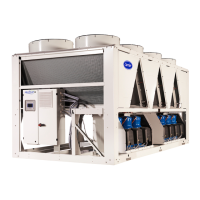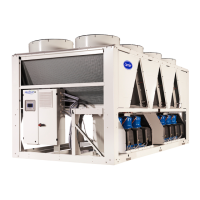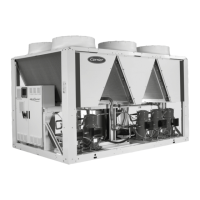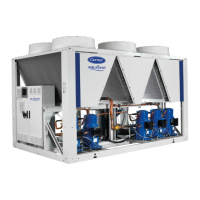56
12.2.7 - Units with variable operating pressure fans (Option 12)
Ductable units are intended to be ducted on the fan discharge,
and can be installed inside a machine room.
For this type of installation, the hot or cold air produced by
the air-cooled exchangers is evacuated from the building by
the fans by means of a ductwork system, which causes pressure
drops in the air circuit.
Installing a ductwork system on the fan discharge generates
a pressure drop due to the air ow resistance.
The intake air can be recovered either inside or outside the
room.
Therefore, more powerful fan motors are installed in this
option than on the standard units.
For each installation, the duct pressure drops differ, depending
on the duct length, the duct section and the direction changes.
Ductable units equipped with this option are designed to
operate with ducts whose air evacuation generates a maximum
pressure drop of 200 Pa.
Using a speed variation up to 19 rps enables the system to
overcome the pressure drops in the ducts while maintaining
an optimised air ow in each circuit.
All the fans in the same circuit run at the same time at the
same speed.
In the cooling/heating mode, the full load or partial load speed
is controlled by a patented algorithm that permanently
optimizes the condensation/evaporation temperature to
ensure the best unit energy efciency (EER/COP) whatever
the operating conditions and pressure drop of the system
ductwork.
If required by a specic installation, the unit's maximum fan
speed can be congured in the Service Conguration menu.
For this modication, consult the control manual.
The maximum congured speed applies to both the cooling
and heating modes.
The performances (capacity, efciency, noise level) depend on
the fan speed. Please refer to the manufacturer's electronic
catalogue to evaluate the estimated impact of the duct system
on the unit's operating conditions.
12.2.7.1 - Specic installation on ductable units
IMPORTANT:
In units which are ductable in heating mode, dehumidication
of ambient air, as well as defrosting of the air-cooled
exchangers, produces a large volume of condensates which
must be dealt with on the unit installation site.
Ductable units must be installed on a waterproof base enabling
efcient drainage and evacuation of the condensate from the
heat exchangers.
Similarly, in case of low outdoor temperatures when air-cooled
exchangers freeze, the water from defrosting must be collected
so as to prevent any risk of ooding the rooms where the heat
pumps are installed.
Each fan is controlled by a variable speed drive. Therefore
each circuit operates independently.
Each refrigerating circuit must have an independent ductwork
system so as to prevent any air recycling between the air-cooled
exchangers of different refrigerating circuits.
On ductable units, each fan is equipped with a factory-tted
connection interface frame providing a link between the
ductwork itself and the refrigerating circuit to which the fan
belongs.
Refer to the dimensional plans of the units for the precise
dimensions of this connection interface.
Please refer to the "Fan arrangement" paragraph to allocate
each fan to its own circuit.
12.2.7.2 - Nominal and maximum air ow rate per circuit and per
unit type
5200 / 6240 10400 / 12480
180-230 10400 / 12480 10400 / 12480
240-270 10400 / 12480 15600 / 18720
310-330 15600 / 18720 15600 / 18720
380 15600 / 18720 20800 / 24960
430-520 20800 / 24960 20800 / 24960
12.2.7.3 - Air connection on discharge
Refer to the dimensional plans of the units for the precise
dimensions of the connection interface.

